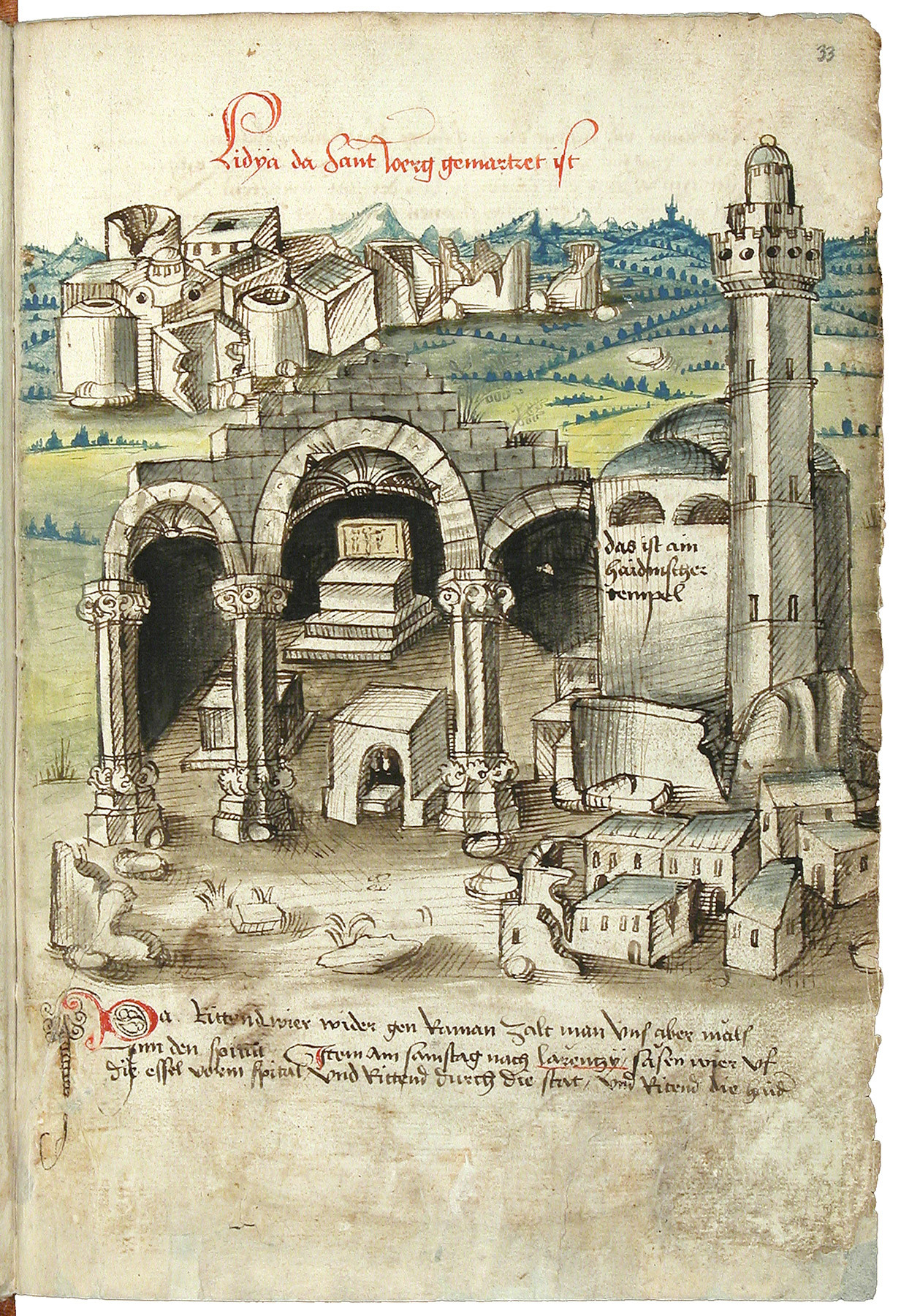
Oppressed in the East – Oppressing in the West: Christians in Rudolf Glaber’s (Hi)story of the Destruction of the Holy Sepulcher and the Church of St. George

The ruined Church of St. George and the adjacent mosque in Ramla, depicted in Konrad von Grünenberg’s ‘Description of the journey from Konstanz to Jerusalem’, 1487 (Cod. St. Peter, pap. 32; Manuscript, Lake Constance area (Konstanz?; PDM)
This project seeks to explore the co-production of story and history and its impact on how Judaism, Christianity, and Islam understood and shaped one another by exploring events presented in a relatively unknown source which, in retrospect, contributed to the Crusades. The western chronicler, Benedictine monk, and theologian, Rudolf Glaber (*985, Burgundy; †~1047, Saint-Germain d’Auxerre), reports in his Historiae(written between 1031 and 1047) that at the beginning of the 11th century a monk called Robert started from France on a pilgrimage to the Holy Land. Rudolf states that the Jews of France gave Robert a letter for the Muslim ruler in Jerusalem, al-Hākim bi-amr Allāh (985-1021). According to Rudolf’s report, this letter advised al-Hākim to destroy the Holy Sepulcher in Jerusalem and St. George’s Church in Ramla if he wanted to prevent the Christians from taking power. Robert obviously tells this story to provide his Christian readers with a history that explains the destruction of the Holy Sepulcher and St. George. In Rudolf’s presentation of the (hi)story, Jews in the West were responsible for destruction in the East. Rudolf goes on to describe how Jews in the West were persecuted and oppressed because of their involvement in this catastrophe in the Holy Land: He tells how the Jews of France and in particular of Orléans went underground to avoid persecution, violence, and forced baptism and only resurfaced five years later, with the rebuilding of the Holy Sepulcher.
It is striking that Rudolf creates a certain image of the agents’ religions by presenting the Jews in the West as responsible for the Muslim oppression of Christians in the East. Judaism is blamed for the disaster; the Muslim ruler is the executor of the evil deed, and is described, in Rudolf's words, as the devil. What consequence does this have for his view of his own religion, Christianity, and of other religions?
This question is at the center of my project on the Historiae. Rudolf reports in the West on a disastrous event in the East and at the same time locates the origin of this disaster in his own context. By tracing the destruction of the two Churches in the Holy Land back to a letter from Frankish Jews, he not only anchors the event itself in the Christian consciousness, but also the role played by the Jews in the West. This will have been prompted by how Rudolf himself perceived Christianity, Judaism, and Islam, on the basis of real and imaginary interactions. But it will also have influenced how Christian readers saw themselves in relation to others.
In order to better understand the dynamics of co-production of both story and history, as well as religious self- and otherness, I will analyze Rudolf’s literary references to religious interactions and place them against a larger interreligious background: first, the encounter between Christians and Muslims in Jerusalem and the Holy Land under Muslim rule; second, Christian-Jewish interaction in France under Christian rule, where Rudolf locates the Jews responsible for the event; and third, the alleged Jewish-Muslim collaboration in the oppression of the Christian minority living under Muslim rule. While the first two have roots in the reality, the third is most likely a fiction motivated by Christian theology and (church-)political goals.
Rudolf's work is an example of the tendency to see local religious conflicts in a global context, or in other words: a singular non-peaceful event prompts further to violence and discrimination elsewhere. In Rudolf's case, the event is used to connect religious conflicts in his own Western context with an Eastern event. From the Christian point of view, the solution is to use the destruction of the churches and thus one’s own oppression in the East to legitimize the Christian oppression of Jews in the West. This tendency not only has models in history, but can also be found in the present, for instance the justification of anti-Jewish polemics in the West based on the Israeli state’s policy towards Palestinians in the East or the Israeli mobilization of the antisemitism of the Shoah to justify the Jewish disenfranchisement of Palestinians. By considering the theme’s relevance today, my project will also explore the relevance of religious co-production for ongoing religious conflicts.